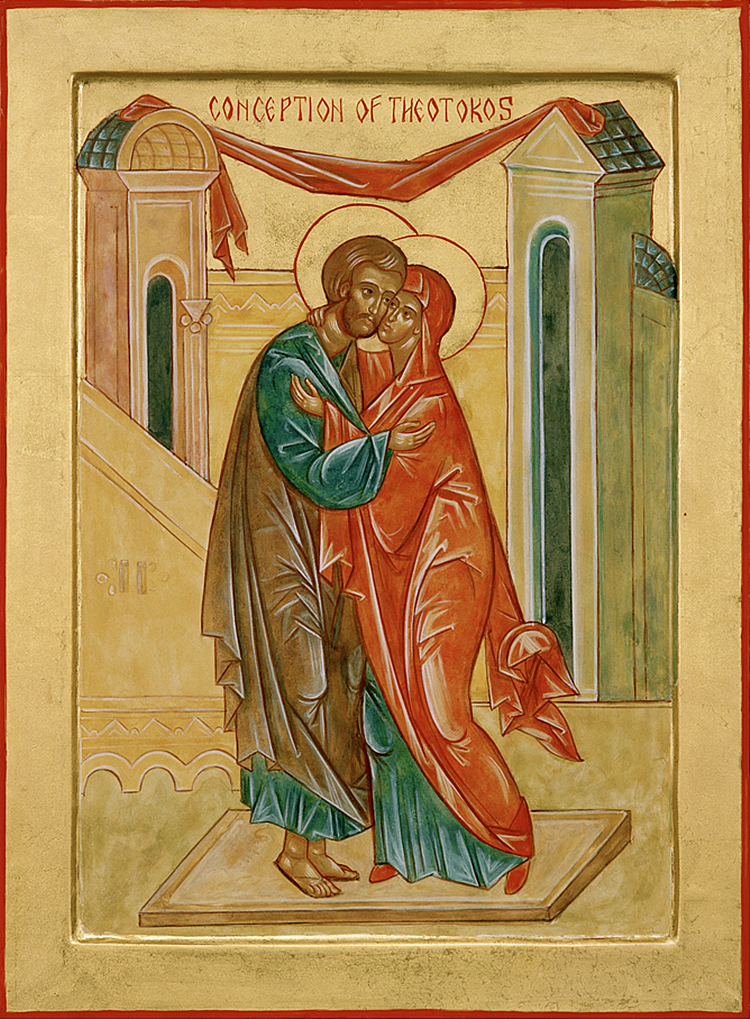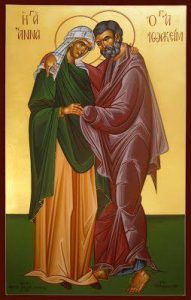 December 8 (December 9) THE MATERNITY OF THE HOLY ANNA
December 8 (December 9) THE MATERNITY OF THE HOLY ANNA
The conception of the all-holy virgin Mary in the womb of Anna is celebrated on December 9 in the Byzantine tradition, for a natural reason, that the Eastern ancients thought a girl was in the womb one day less than a boy. The [Ukrainian Catholic Church in America celebrates the feast on December 8] Ruthenian Church in America, celebrates the feast together with the Roman Church because she is the patron of the United States.
It is clear that this is a preparation for the birth of Christ on Christmas, for the first sticheron of the feast begins: “The barren Anna leaped for joy when she gave birth to Mary the Virgin who in turn will give birth in the flesh to God the Word.” Mary, the daughter of Anna and Joachim by way of natural birth is to be the temple of the Word of God incarnate for our sake and for our salvation.
The Eastern and Western Churches put the accent on different aspects of the feast. In the East, we celebrate the miracle of God taking away the barrenness of Anna’s womb. The Protoevangelium of James portrays the sadness of Joachim and Anna. Joachim lamented, “I have searched whether I am the only one who has not begotten offspring in Israel, and I have found of all the righteous that they had raised up offspring in Israel.” Anna wept, “I will bewail my widowhood, and bewail my childlessness.” (1,3 and 2,1) Two angels came, one to Joachim and another to Anna with a divine message that they would bear a child, even in their old age. When God takes away an emptiness, he fills us more than our faith can grasp, and they gave birth not only a child, but to the new Ark of God’s covenant with us.
The Western Church, on the other hand, puts the accent on Mary’s purity from all sin from her conception, defined by Pope Bl. Pius IX in 1848 as the Immaculate Conception. The theology behind this is that the incarnation of the sinless Word of God must come from a sinless temple, the womb of Mary which was never touched by sin, even from her conception.
It is unfortunate that this dogma has become a bone of contention between the Catholic and Orthodox Churches. Both believe in the ancestral sin, but in different ways, so that for the Orthodox the main curse of the sin of Adam and Eve is death, while for the Catholics, it is original sin. May we seek unity and not division. Most Orthodox theologians do believe that the “ancestral sin” has infected the human race, but might disagree about the way it does this. In our dialogue, we must seek a mutual understanding, perhaps in the words of Orthodox theologians who saw a “pre-purification” in Mary. “And in every way [the Lord] became a man, save sin, for he had been conceived from a virgin, after she had been pre-purified with respect to soul and body through the Holy Spirit.” (Gregory the Theologian, Homily 38 on the Theophany) or St. John Damascene, who wrote, “O all-blessed loins of Joachim, from which the all-pure seed was sown. O epic womb, in which the all-holy infant was born, after she was formed, and a little later increased by nutriments from Anne. Her (Anne’s) belly conceived in itself an ensouled heaven, wider than the wide space of heaven.” (Both quotes from Christian Kappes’ book, The Immaculate Conception 21 and 60)
In both cases, the conception of the Theotokos in the womb of Anna today is our preparation for Christmas. For God took away the barrenness of one couple in a conception that would have a cosmic dimension for every one of us: the coming into the world of it’s Creator, who would take away the curse on Adam and Eve by the birth of his Son with the power to bring us all into sinlessness. Receiving his body and blood in Communion, the priest prays, “may this be for the remission of sins and life everlasting.” The Hymn of Light at Matins thus proclaims: “Today Anna conceives the One who will give birth to the Light which illumines all creation. Therefore, let us all gather together, for the one who delivers us from the judgment of Eve now comes forth.”
 The conception of the all-holy virgin Mary in the womb of Anna is celebrated on December 9 in the Byzantine tradition, for a natural reason, that the Eastern ancients thought a girl was in the womb one day less than a boy. However, in the Ruthenian Church in America, the feast is now celebrated together with the Roman Church on December 8, nine months before her birth on September 8, because she is the patron of the United States.
The conception of the all-holy virgin Mary in the womb of Anna is celebrated on December 9 in the Byzantine tradition, for a natural reason, that the Eastern ancients thought a girl was in the womb one day less than a boy. However, in the Ruthenian Church in America, the feast is now celebrated together with the Roman Church on December 8, nine months before her birth on September 8, because she is the patron of the United States.